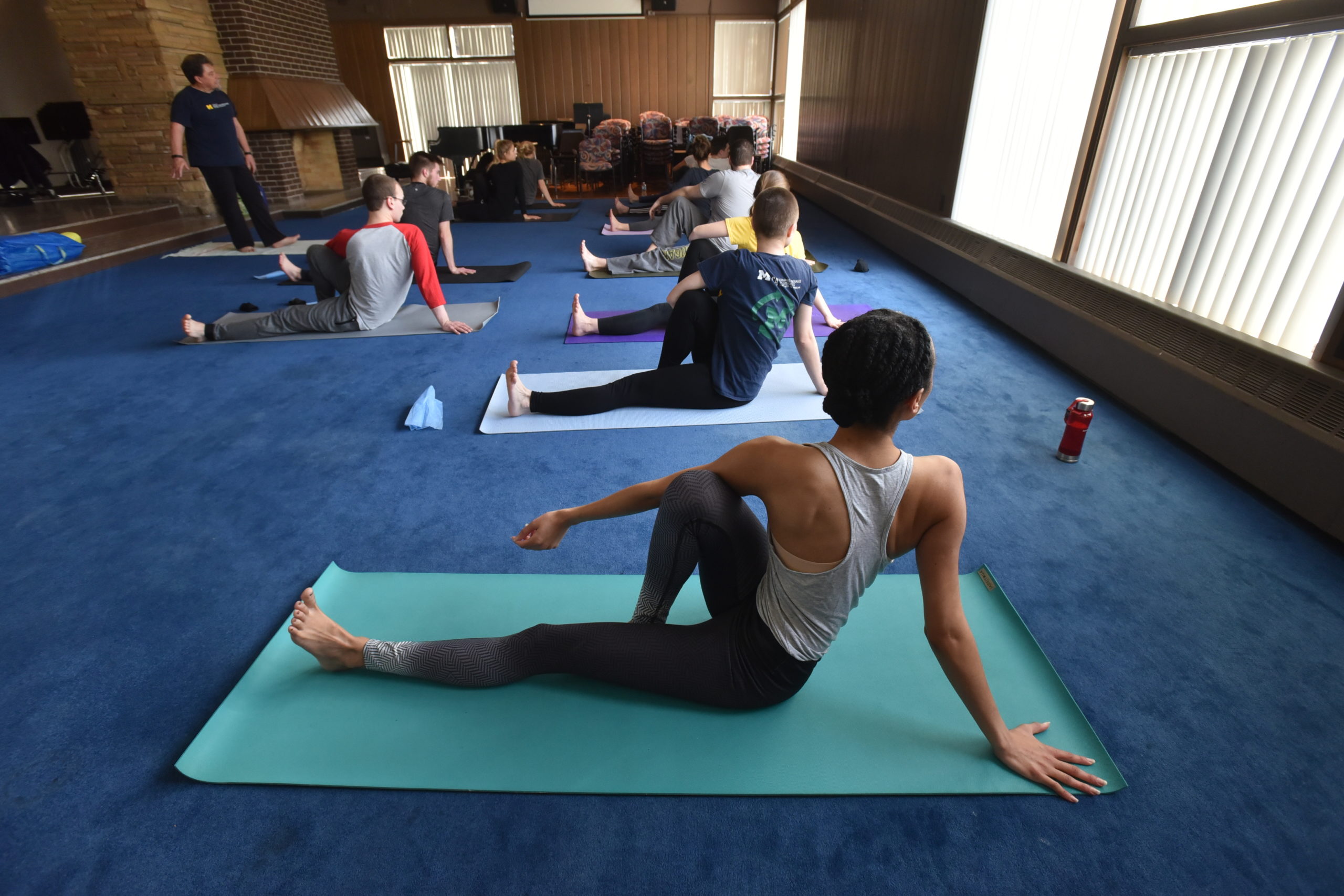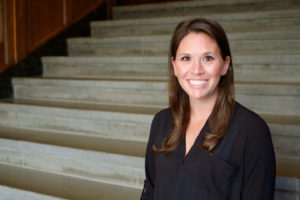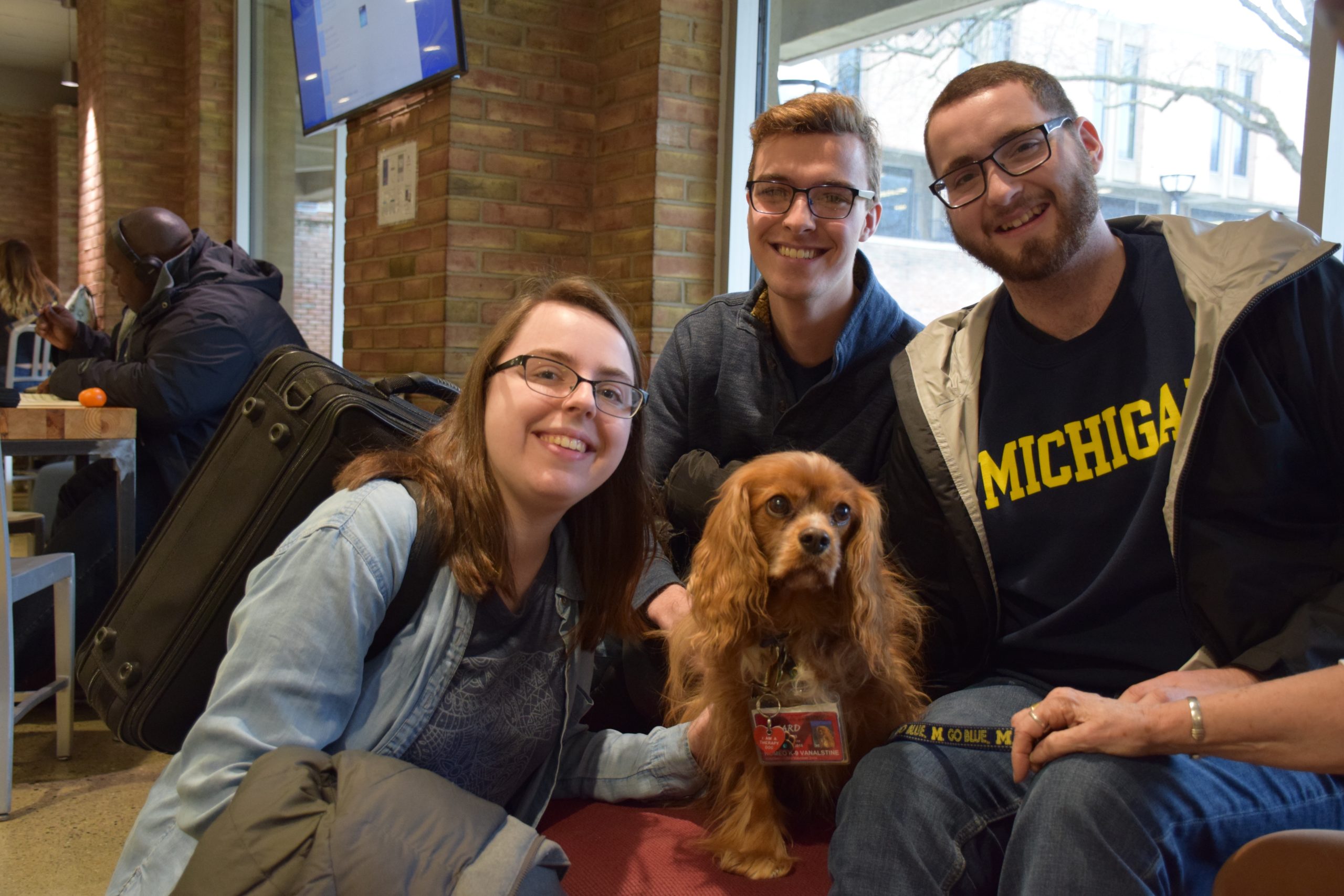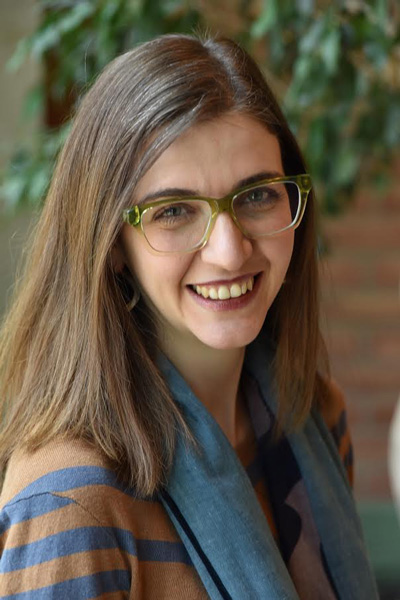By Marilou Carlin, director of communications and editor of Michigan Muse
SMTD’s new Wellness Initiative is addressing the unique physical and psychological challenges faced by performing arts students.
With the exception of intercollegiate athletics, there is no program at the University of Michigan that is more physically taxing than the study of the performing arts. Instrumentalists, singers, dancers, and actors constantly use their bodies in service to their art, often inflicting repetitive stress and pain that cannot be avoided. A recent survey conducted at the School of Music, Theatre & Dance revealed that approximately 80 percent of current students experienced some kind of pain at some point during their college careers.
“It’s easy to forget that performing artists are also performing athletes,” said Mark Clague, interim dean of academic affairs. “They engage in extraordinary physical feats, whether it’s a dancer executing a seemingly endless pirouette, a pianist playing roulades of Lisztian passagework, or an actor delivering a convincing Shakespearean sword fight with a 50-pound broadsword.”
Coupled with these physical challenges are unique mental stressors. The high level of competition, striving for perfection, stage fright, anxiety about what their careers will look like in a field that can be both highly competitive and intrinsically uncertain—any or all of those factors can contribute to compromised mental or emotional health.
These issues are not unique to Michigan students, of course; all performing arts students face the same challenges. At SMTD, however, a concerted effort is being made to address both the physical and psychological well-being of students through a comprehensive Wellness Initiative. Both holistic and preventive, the initiative is distinguished by on-site services, full-time staff, and the resources of Michigan’s top-rated medical program and comprehensive wellness programs.
“The great thing about the University of Michigan is that we do everything, and we do everything at a level of national excellence,” said Clague. “So even though SMTD’s wellness program is only in its second year, I believe our resources will allow us to become a national leader in this area.”
Access Is Everything
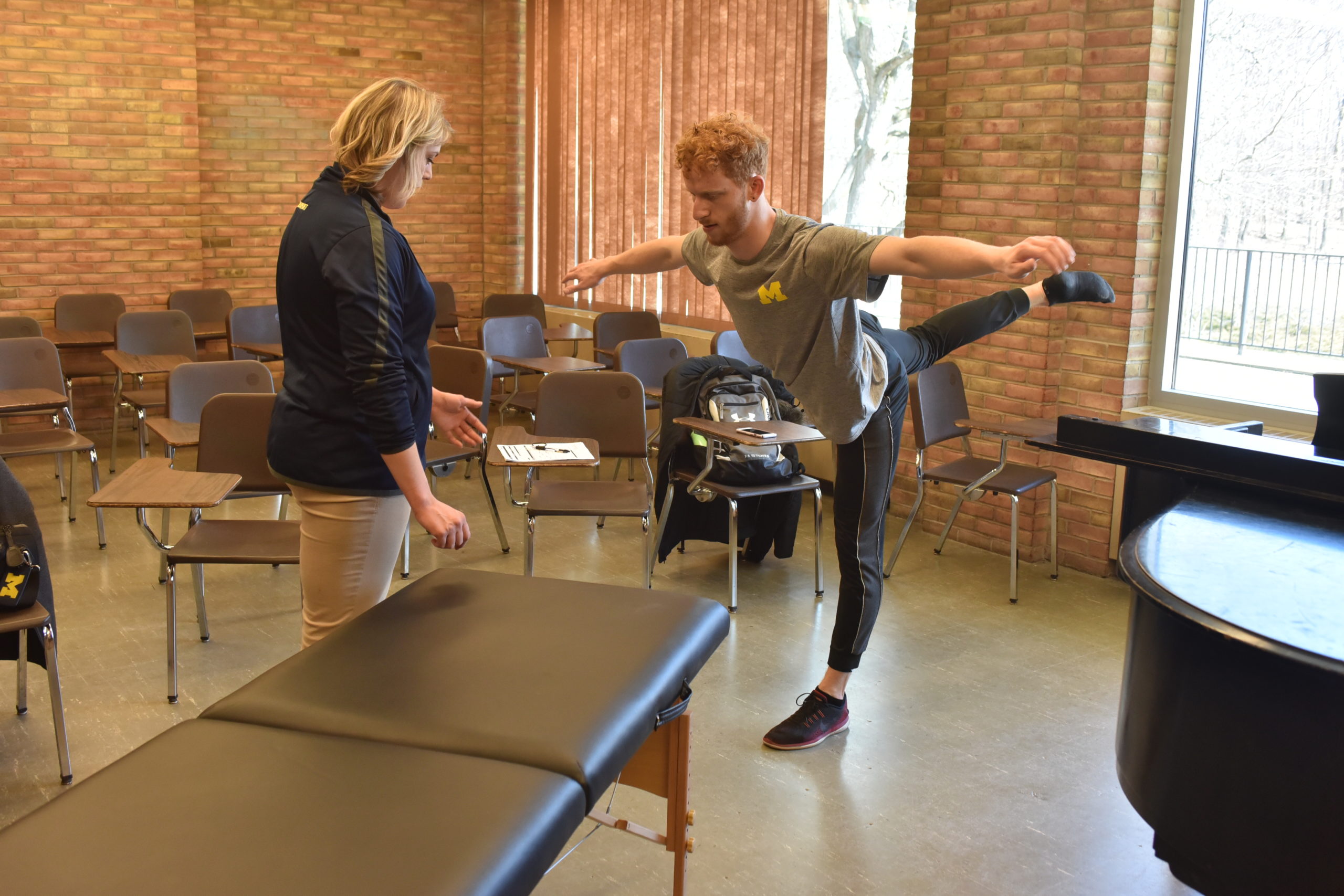
JP Wogaman II, a trumpet player who is also enrolled in multiple dance classes, being assessed by MedSport clinician Megan Mahoney
SMTD’s Wellness Initiative was instigated by Interim Dean Melody Racine, who, in her role as associate professor of voice, has long been involved with Michigan Medicine’s Vocal Health Center. She works at the Center with otolaryngologist Dr. Norman Hogikyan and with a speech therapist to treat not only performing artists, but patients of all kinds who have voice problems.
Racine finds this work tremendously rewarding, and it made her keenly aware of how devastating an injury can be to an individual’s overall sense of well-being, heightening her concerns about student health.
“As a performer, when something in you fails, whether it’s physical or mental, the effect it can have on the spirit and the soul can be devastating,” said Racine. “It was clear to me that we should be adopting proactive and preventive care with our students, who face a unique spectrum of health risks.”
In her previous role as associate dean of student and faculty affairs, student care was among Racine’s responsibilities. She came to realize that North Campus students did not have easy access to the University’s Counseling and Psychological Services (CAPS) counselors; they were all based at CAPS’ offices on Central Campus, requiring time and effort for SMTD students to travel to them for help.
Racine knew that a student with a pressing mental health issue would be more likely to seek help if that help was down the hall—or down the block—rather than a bus ride away. So she inquired about the possibility of having counselors located on North Campus. She was thrilled when CAPS administrators offered to embed a counselor within SMTD, and was even more excited when SMTD administration unanimously agreed to the plan, despite the School’s perpetual challenge with available space.
“I’m so proud that our administration made this commitment to our students, despite the obstacles,” said Racine, “and I’m also proud that SMTD became the first unit on campus to embed a counselor.”
CAPS, with the support of the Vice President for Student Life and the Office of the Provost, decided to expand the model, and the embedded-counselor program is now available at 12 of Michigan’s 19 schools and colleges.
Emily Hyssong was hired as SMTD’s CAPS counselor and was provided an office in the E.V. Moore Building. Hyssong is uniquely qualified: a licensed master social worker, she is also an SMTD alumna who double-majored in viola and psychology as an undergrad. As such, she has an empathetic understanding of the special challenges that performing artists face.
“Being a performer is a different way of experiencing college,” said Hyssong. “At Michigan, where we have so many talented students, it can be a really difficult transition from, say, your high school, where perhaps you were the best, to being here, where you’re among peers who are all exceptionally talented. Having to evaluate or compare yourself to others at that level can be really challenging.”
Hyssong cites perfectionism and competition with peers as a deeply rooted part of how artists see themselves as people. Failing at an audition or not performing as well as hoped is especially hard-hitting.
“I talk a lot about self-compassion with students—how to be a little more accepting and tolerant about being good enough,” said Hyssong. “As artists, we want to challenge ourselves to do the best that we can, but we need to know when that gets in the way of our own success and our well-being.”
In addition to one-on-one sessions with Hyssong, the mental health program now offers a variety of on-site services for students including drop-in meditation sessions; a lunch workshop series with Hyssong to promote positive coping, mindfulness, and self-compassion practices; a semester-ending stress-relieving event; and courses such as a Contemplative Practices Seminar and The Inner Business of Music.
Hyssong notes that a huge benefit to being on site, week in and week out, is that it helps to destigmatize the notion of seeking help from a counselor. By being a steady presence in their daily lives, Hyssong is familiar to students.
“I make sure students know who I am so it’s not a big deal when they want to come talk to me. It’s less of a barrier for them since I’m already in the building and they know what my face looks like.”
“I think the normalization of counseling has been really good for our students,” echoed Racine. “And for them to be okay with not being okay. Just knowing they have a safe place that goes beyond faculty is incredibly important. Sometimes they’re not interested in talking to faculty about their challenges, about something that they might consider a weakness, a crack in their armor. Having Emily here helps them separate, and it provides a place of safety to examine whatever the issue might be.”
The Wellness Umbrella
With the success of the embedded CAPS counselor, Racine and senior administration began looking at what else they should be doing. “We saw immediately the change in climate in terms of normalizing counseling, and giving students the opportunity to get to someone in minutes if they needed to talk to them,” said Racine. “And that got us thinking more broadly in terms of ‘what is wellness?’”
The answers came in the fall of 2016 when wellness coordinator Paola Savvidou was hired to manage the Wellness Initiative. She was charged with adding preventive medicine and injury recovery onto the existing counseling and psychological services to create a full-spectrum wellness program under one umbrella.
Savvidou has an extensive background in both music and wellness practice. With both a master’s and a DMA in piano performance and pedagogy from the University of Wisconsin, she began incorporating her research into wellness for the performing artist as an assistant professor of piano pedagogy at the University of Missouri. She won “Article of the Year” from the Music Teachers National Association two years in a row: for “In Search of the ‘Perfect’ Musical Performance,” published in the American Music Teacher in 2015, and for her interdisciplinary research article “Assessing Injury Risk in Pianists: Using Objective Measures to Promote Self-Awareness,” published in the MTNA e-Journal in 2016.
“Ours is a really vulnerable population due to the intensity of what we do—the overuse and misuse of our muscles,” said Savvidou. “And that can be exacerbated by stress—the competition, the pressure to be your best at all times; that can cause a physical reaction, creating even more tightness in the muscles.”
Savvidou has been instrumental in taking advantage of the vast resources of U-M and partnering with several of the exceptional Michigan Medicine programs, such as MedSport, the University’s comprehensive sports medicine program. The result is the Performing Arts Health Clinic, open to SMTD students, faculty, and staff, which brings therapists on site to the dance and music buildings. It offers one-on-one appointments with MedSport clinicians to deal with a variety of physical challenges, and with hand specialists to focus on hand maladies that instrumentalists encounter.
“These clinics have been thriving,” said Savvidou. “We doubled capacity from the first semester they were offered. Carving out the time for students to take care of their bodies and go off campus for treatment can be challenging when they are so busy with classes and rehearsals. Having the clinic on site makes it so much easier for them.”
In addition, the MedSport partnership provides for on-site neuromuscular and musculoskeletal assessments for freshmen. The assessments set the students up for successful careers by helping them—from the start of their enrollment—to be mindful of their postures, to be aware of any misalignments, and to receive personalized training to address issues.
Courses dealing with physical wellness are also offered, such as yoga and Alexander Technique, and a holistic course taught by Savvidou titled “Wellness for the Performing Artist.” In addition, the SMTD website now hosts an extensive list of University resources directing students to the many avenues of help, treatment, and support that are readily available at U-M, such as the Comprehensive Depression Center, SAPAC (the Sexual Assault and Prevention and Awareness Center), and The Spectrum Center, U-M’s Office of LGBT Affairs.
“We really wanted to create an environment at SMTD where students feel supported and know that we care and want them to be successful in the long run,” said Savvidou. “Being able to prevent injuries is the best way to approach it. But if we’re too late, we have services to deal with injury, and we’re able to connect students to the right resource to get help right away.”
Although the program has grown exponentially in the short time since Hyssong and Savvidou were hired, further expansion is a priority.
“Having more services on-site—physical trainers, physical therapy, or massage as a preventive tool—will hopefully be the next step,” said Savvidou. “And we’d love to expand the clinics. Being able to serve every student who needs it would be amazing.”
Racine agrees. “There’s a larger vision that we can certainly pursue, research that can be done, so I definitely see this initiative expanding. But I think we’ve gotten off to a tremendous start.”


